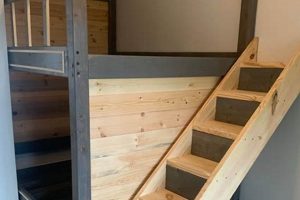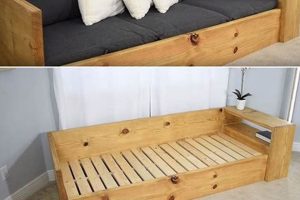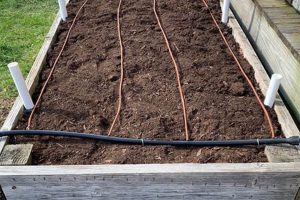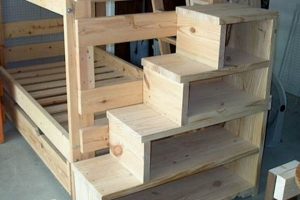Constructing a support structure within a pickup truck bed to secure bicycles during transport represents a practical solution for cyclists. These supports, typically crafted from readily available materials, prevent bikes from shifting or falling over while the vehicle is in motion, protecting both the bicycles and the truck bed from damage. For instance, a simple wooden frame with fork mounts can be built to hold bikes upright by their front forks.
Implementing such a system offers several advantages. It eliminates the need for external hitch-mounted or roof-mounted carriers, which can be expensive and impact vehicle aerodynamics. Securing bikes inside the truck bed keeps them out of the elements, reducing exposure to rain, wind, and potential theft. The concept also caters to the growing interest in personalized solutions and cost-effective alternatives to commercially available products. Historically, individuals have sought similar means to transport various cargo securely, adapting available materials and skills to meet specific needs.
The following sections will delve into specific design considerations, material selection guidelines, and step-by-step construction methods for creating a reliable and functional bicycle retention system within a pickup truck bed.
Practical Advice for Truck Bed Bicycle Supports
The subsequent points offer guidance on designing and building a durable bicycle support system for a pickup truck bed. Adhering to these recommendations promotes safety and longevity.
Tip 1: Secure Fork Mount Selection: Prioritize fork mounts manufactured from robust materials such as aluminum or steel. Ensure compatibility with the bicycle’s fork type (e.g., quick-release, thru-axle) to prevent damage during transit.
Tip 2: Material Durability Assessment: When using wood, opt for pressure-treated lumber or apply a sealant to protect against moisture and rot. For metal frames, consider rust-resistant coatings or alloys to withstand environmental exposure.
Tip 3: Frame Stability Reinforcement: Incorporate bracing and gussets into the support structure to enhance rigidity and prevent flexing under load. This is particularly crucial for transporting multiple or heavier bicycles.
Tip 4: Bed Liner Compatibility: Account for the truck bed liner’s thickness when determining mounting hardware length. Ensure bolts are sufficiently long to securely fasten the support to the truck bed without damaging the liner.
Tip 5: Bicycle Spacing Optimization: Maintain adequate spacing between bicycles to prevent contact and potential damage during transport. Consider varying handlebar heights and orientations to maximize space utilization.
Tip 6: Secure Fastening Mechanism: Employ robust tie-down straps or ratchet straps to further secure bicycles to the support structure. These straps should be rated for the combined weight of the bicycles being transported.
Tip 7: Pre-Trip Inspection Protocol: Before each journey, inspect the support structure, fork mounts, and tie-down straps for signs of wear or damage. Replace any compromised components immediately.
Implementing these recommendations will contribute to a secure and dependable bicycle transport solution, minimizing the risk of damage to equipment and ensuring safe arrival at the destination.
The next section will explore potential safety considerations and best practices related to using these constructed supports.
1. Structural Integrity
Structural integrity is paramount in the context of a fabricated bicycle support for a pickup truck bed. The system’s ability to resist deformation or failure under load directly impacts the safety and security of the transported bicycles and the overall safety of the vehicle.
- Material Selection and Load Capacity
The choice of materials, whether wood, steel, or aluminum, dictates the support’s load-bearing capability. Each material possesses distinct strength characteristics. For instance, steel offers superior tensile strength compared to wood, allowing it to withstand greater stress without yielding. The selection must account for the combined weight of the bicycles being transported, including considerations for dynamic forces experienced during braking and acceleration.
- Joint Construction and Reinforcement
The manner in which the support’s components are joined significantly influences its overall strength. Weak or poorly executed joints can become points of failure. Welding, bolting, or the use of structural adhesives are common methods. Reinforcement techniques, such as gussets or bracing, can further strengthen these connections, distributing stress and preventing localized failures. Examples include adding triangular supports at the corners of a wooden frame or using welded gussets on a steel structure.
- Frame Design and Stress Distribution
The overall design of the support must effectively distribute stress throughout the structure. Designs that concentrate stress at specific points are more prone to failure. A well-designed frame will distribute the load evenly, minimizing stress concentrations. For example, a frame utilizing a triangular geometry inherently provides greater stability and resistance to deformation compared to a rectangular frame of the same material.
- Fatigue Resistance and Long-Term Durability
Repeated stress cycles, even at loads below the material’s yield strength, can lead to fatigue failure over time. The support must be designed to withstand the cumulative effects of these stress cycles. Factors such as material selection, joint design, and the presence of stress concentrators influence fatigue life. Surface treatments, such as powder coating or galvanizing, can improve resistance to corrosion, further extending the support’s lifespan.
In conclusion, structural integrity is not merely a theoretical concern but a practical imperative for any constructed bicycle support system. By carefully considering material properties, joint construction, frame design, and fatigue resistance, a secure and reliable system can be fabricated, ensuring the safe transport of bicycles within a pickup truck bed.
2. Mount Compatibility
Mount compatibility represents a critical design consideration when constructing a bicycle support for a pickup truck bed. Incompatibility between the bicycle’s fork or frame and the chosen mounting system introduces the potential for damage to both the bicycle and the support structure. This issue arises because bicycles employ various fork and axle standards, requiring correspondingly specific mounting hardware. For instance, a bicycle with a thru-axle fork cannot be securely fastened to a mount designed exclusively for quick-release axles. Similarly, frame mounts must be compatible with the frame’s tube diameter and shape. This mismatch can lead to instability during transport, increasing the risk of bicycle movement, abrasion, or complete detachment from the support.
The selection of appropriate fork or frame mounts necessitates a thorough assessment of the bicycle’s specifications. Manufacturers often provide detailed information regarding axle type, fork dimensions, and frame tube diameters. This information enables informed decisions concerning the purchase or fabrication of compatible mounting hardware. Furthermore, the design of the support itself must accommodate the chosen mounts. The position and orientation of the mounts should align with the bicycle’s geometry, ensuring a secure and stable interface. For example, a support designed to accommodate multiple bicycles may require adjustable mounts to accommodate variations in bicycle size and frame design.
In conclusion, mount compatibility is not merely a desirable feature but a fundamental requirement for a functional and safe bicycle support system within a pickup truck bed. Ignoring this aspect can lead to equipment damage and potential safety hazards. The successful integration of compatible mounting hardware relies on a comprehensive understanding of bicycle specifications and a meticulously planned support structure design. The careful consideration of these elements contributes to a secure and reliable transport solution.
3. Material Durability
The longevity and reliability of a support system engineered for securing bicycles within a pickup truck bed are intrinsically linked to the durability of the materials employed in its construction. Material selection directly influences the structure’s ability to withstand environmental exposure, repetitive stress, and the weight of the transported bicycles. Corrosion, fatigue, and impact damage represent potential failure modes that can compromise the functionality and safety of the entire system. For example, untreated wood exposed to moisture can rot, weakening the structure, while steel components lacking protective coatings are susceptible to rust, potentially leading to structural failure.
Implementing durable materials and appropriate protective measures translates directly into reduced maintenance, extended lifespan, and increased safety. Pressure-treated lumber or steel coated with powder coating, for instance, can significantly improve resistance to environmental degradation. Employing robust fasteners and implementing sound construction techniques further contribute to the system’s overall durability. Consider the difference between a support built with thin-walled steel tubing versus one constructed with thicker, higher-grade steel; the latter offers superior resistance to bending and deformation under load. Similarly, stainless steel hardware provides greater corrosion resistance compared to standard steel hardware, particularly in regions with high humidity or coastal environments.
In summary, material durability is not a peripheral consideration but rather a foundational element in the creation of a reliable and safe bicycle support for a pickup truck bed. The selection of appropriate materials and the implementation of effective protective measures are critical to ensuring the system’s long-term performance and minimizing the risk of failure. The integration of these considerations reflects a commitment to quality and a proactive approach to safety, ultimately contributing to the overall utility and value of the constructed support system.
4. Secure Fastening
Secure fastening constitutes a core principle in the effective design and utilization of any bicycle support constructed for a pickup truck bed. The primary function of such a support is to prevent movement of the bicycles during transit. Inadequate or improperly implemented fastening mechanisms negate the benefits of the support structure, increasing the risk of damage to the bicycles, the truck bed, and potentially causing hazardous conditions. Cause and effect are directly linked; a weak fastening system inevitably leads to instability, while a robust and well-engineered system ensures secure transport. The importance of secure fastening cannot be overstated, as it is the ultimate safeguard against uncontrolled movement during vehicle operation. For instance, imagine a wooden support frame with fork mounts, where the bikes are simply placed and not strapped. During a sudden stop, the bikes will inevitably shift forward, impacting the front of the truck bed. Alternatively, a system incorporating heavy-duty ratchet straps ensures the bicycles remain firmly in place, irrespective of driving conditions.
Effective securement strategies involve a multi-faceted approach. The choice of fastening hardware, such as straps, clamps, or bolts, must correspond to the weight and dimensions of the bicycles being transported. Furthermore, the method of attachment to both the bicycles and the truck bed must be carefully considered. Attachment points should be structurally sound and capable of withstanding significant forces. Utilizing multiple attachment points per bicycle further enhances security and redundancy. For example, in addition to fork mounts, securing the bicycle frame to the support structure with durable straps adds a layer of protection against lateral movement. Moreover, a pre-trip inspection of all fastening components is essential to identify any signs of wear or damage. Replacement or repair of compromised components should occur immediately to maintain the integrity of the system.
In summary, secure fastening is an indispensable element of a successful bicycle support system for a pickup truck bed. It directly influences the safety and reliability of the entire system. Neglecting this aspect compromises the intended functionality and introduces unnecessary risks. By prioritizing robust fastening mechanisms, employing appropriate attachment techniques, and adhering to regular inspection protocols, a secure and dependable bicycle transport solution can be achieved.
5. Space Optimization
Efficient allocation of available space within a pickup truck bed is a primary consideration when designing a bicycle support system. Maximizing usable area allows for transporting multiple bicycles or accommodating additional cargo alongside the bicycles.
- Vertical Stacking Potential
Implementing a design that allows for vertical stacking of bicycles, either by alternating handlebar heights or utilizing tiered mounting structures, significantly increases the number of bicycles that can be carried. This approach necessitates careful consideration of weight distribution and the structural integrity of the support frame to ensure stability and prevent damage.
- Angle and Orientation Adjustments
Modifying the angle at which bicycles are mounted or altering their orientation within the truck bed optimizes space utilization. Slight adjustments to handlebar positioning or angling the bicycles towards each other can minimize overall width and free up valuable space for other equipment. However, these adjustments must not compromise the secure fastening of the bicycles or create potential points of contact that could lead to damage during transport.
- Compact Support Structure Design
Minimizing the footprint of the support structure itself is crucial for maximizing available space. A streamlined design, utilizing lightweight yet strong materials, reduces the overall volume occupied by the support system. Folding or collapsible designs offer the additional benefit of freeing up the truck bed when the bicycle support is not in use.
- Integration with Existing Truck Bed Features
Leveraging existing features of the truck bed, such as tie-down points or bed rails, can streamline the support structure and reduce its overall size. Integrating the bicycle support with these features not only saves space but also simplifies installation and removal. However, care must be taken to ensure that the integration does not compromise the functionality of the truck bed’s original features or create potential safety hazards.
Integrating these space-optimizing strategies into the design and construction of a support for securing bicycles in a pickup truck bed allows for efficient use of available area and enhances the overall functionality of the transport solution. Balancing space optimization with secure bicycle fastening and structural integrity is essential for creating a practical and reliable system.
Frequently Asked Questions
This section addresses common inquiries regarding the design, construction, and implementation of a bicycle support system within a pickup truck bed. The information presented aims to provide clarity and promote safe practices.
Question 1: Is professional welding expertise required for constructing a durable metal frame?
While professional welding ensures optimal strength and precision, competent DIYers can achieve satisfactory results with proper equipment and training. Ensure adequate ventilation and adhere to all safety precautions when welding. Bolted or riveted metal frames, though potentially less robust, offer viable alternatives for those lacking welding skills.
Question 2: What is the recommended method for securing a wooden support structure to a truck bed?
Bolting the structure directly to existing tie-down points or utilizing purpose-built bed rail mounting brackets provides a secure and stable attachment. Avoid relying solely on friction or pressure to hold the support in place, as these methods are prone to slippage under dynamic driving conditions.
Question 3: Can a support designed for one bicycle model accommodate others?
Compatibility depends on the adjustability of the fork or frame mounts and the overall design of the support. Universal mounts or adjustable systems offer greater versatility. Always verify that the bicycle is securely fastened and that no components are subjected to undue stress or pressure before commencing transport.
Question 4: What legal considerations apply to transporting bicycles in a truck bed?
Regulations vary by jurisdiction. It is imperative to consult local and state laws regarding load securement and visibility requirements. Ensure that the transported bicycles do not obstruct the driver’s view or pose a hazard to other motorists.
Question 5: How does the presence of a tonneau cover impact the design and functionality of a bicycle support?
A tonneau cover restricts vertical space, necessitating a lower-profile support design. Consider a system that can be easily removed or reconfigured to accommodate the cover. Ensure that the cover does not interfere with the secure fastening of the bicycles.
Question 6: What maintenance procedures are recommended for a bicycle support system?
Regularly inspect all components for signs of wear, corrosion, or damage. Tighten loose fasteners, lubricate moving parts, and address any structural weaknesses promptly. Periodic cleaning and application of protective coatings can extend the lifespan of the support system.
These FAQs offer a starting point for understanding key aspects of constructing a bicycle support system for a pickup truck bed. Thorough planning, careful execution, and adherence to safety guidelines are paramount for creating a reliable and functional solution.
The subsequent section will delve into safety precautions for these constructions.
Conclusion
The preceding discussion has detailed various aspects of constructing a diy bike stand for truck bed. Key considerations include structural integrity, mount compatibility, material durability, secure fastening, and space optimization. Thorough attention to each of these elements is crucial for ensuring the safety of both the bicycles being transported and other vehicles on the road. Improperly designed or constructed systems can lead to equipment damage, personal injury, or even accidents.
Therefore, individuals undertaking such projects should prioritize meticulous planning, utilize appropriate materials and construction techniques, and rigorously test the completed system before use. Understanding and adhering to relevant safety standards and legal requirements is paramount. This careful approach will maximize the utility and minimize the potential risks associated with a diy bike stand for truck bed.







